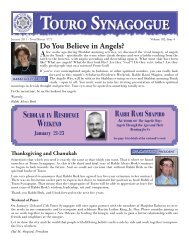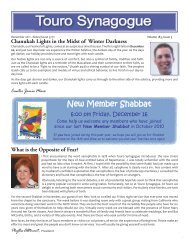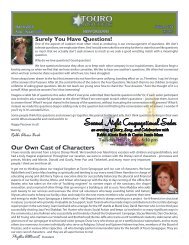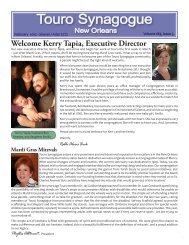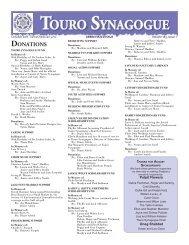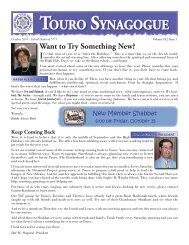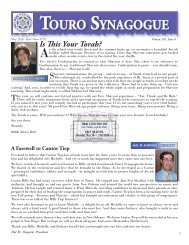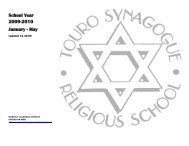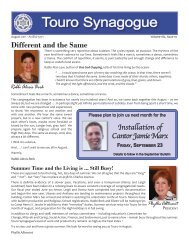Reform Judaism for Teachers module - Touro Synagogue
Reform Judaism for Teachers module - Touro Synagogue
Reform Judaism for Teachers module - Touro Synagogue
You also want an ePaper? Increase the reach of your titles
YUMPU automatically turns print PDFs into web optimized ePapers that Google loves.
1. Share this quotation with the class, either by reading it, by writing it on the board, or<br />
both: “Second only to the Torah, the siddur (prayer book) expresses the ideology of<br />
our people. But because it changes over time and is the book that people regularly<br />
read and use, it defines and unifies us even more than the Torah. In the <strong>Re<strong>for</strong>m</strong><br />
Movement, each new prayer book‐‐despite the almost inevitable controversies that<br />
accompany its publication‐‐has served to unify hundreds of congregations<br />
throughout North America, as well as <strong>Re<strong>for</strong>m</strong> Jews everywhere.” 4<br />
2. Distribute Maariv Aravim prayer sample sheets from the Union Prayer Book, Gates of<br />
Prayer as well as from Mishkan T’filah.<br />
3. Explain that these sheets contain variations of the same prayer presented in three<br />
different prayer books of the <strong>Re<strong>for</strong>m</strong> Movement. Each book illustrates the feelings of<br />
the Movement at that point in time.<br />
4. Share with participants the following in<strong>for</strong>mation or divide them into groups and<br />
ask each group to compare the three versions of the prayer and report on differences<br />
in treatment that they noticed. Ask them what the implications of these differences<br />
might be.<br />
Union Prayer Book<br />
• UPB had a universalist orientation‐‐it rejected such traditional Jewish notions as<br />
peoplehood, chosenness, the personal Messiah, resurrection, and a return to the<br />
Land of Israel. With the desire to build a Jewish homeland, later editions<br />
expressed increasing emphasis on peoplehood.<br />
• UPB eliminated most opportunities <strong>for</strong> congregational participation and<br />
essentially entrusted the liturgy to the rabbi as reader and to a trained choir.<br />
• This prayer book did not incorporate a great deal of Hebrew.<br />
4 Stevens, E. <strong>Re<strong>for</strong>m</strong> <strong>Judaism</strong> Magazine, Summer 2006<br />
Union <strong>for</strong> <strong>Re<strong>for</strong>m</strong> <strong>Judaism</strong>-Department of Lifelong Jewish Learning<br />
21



